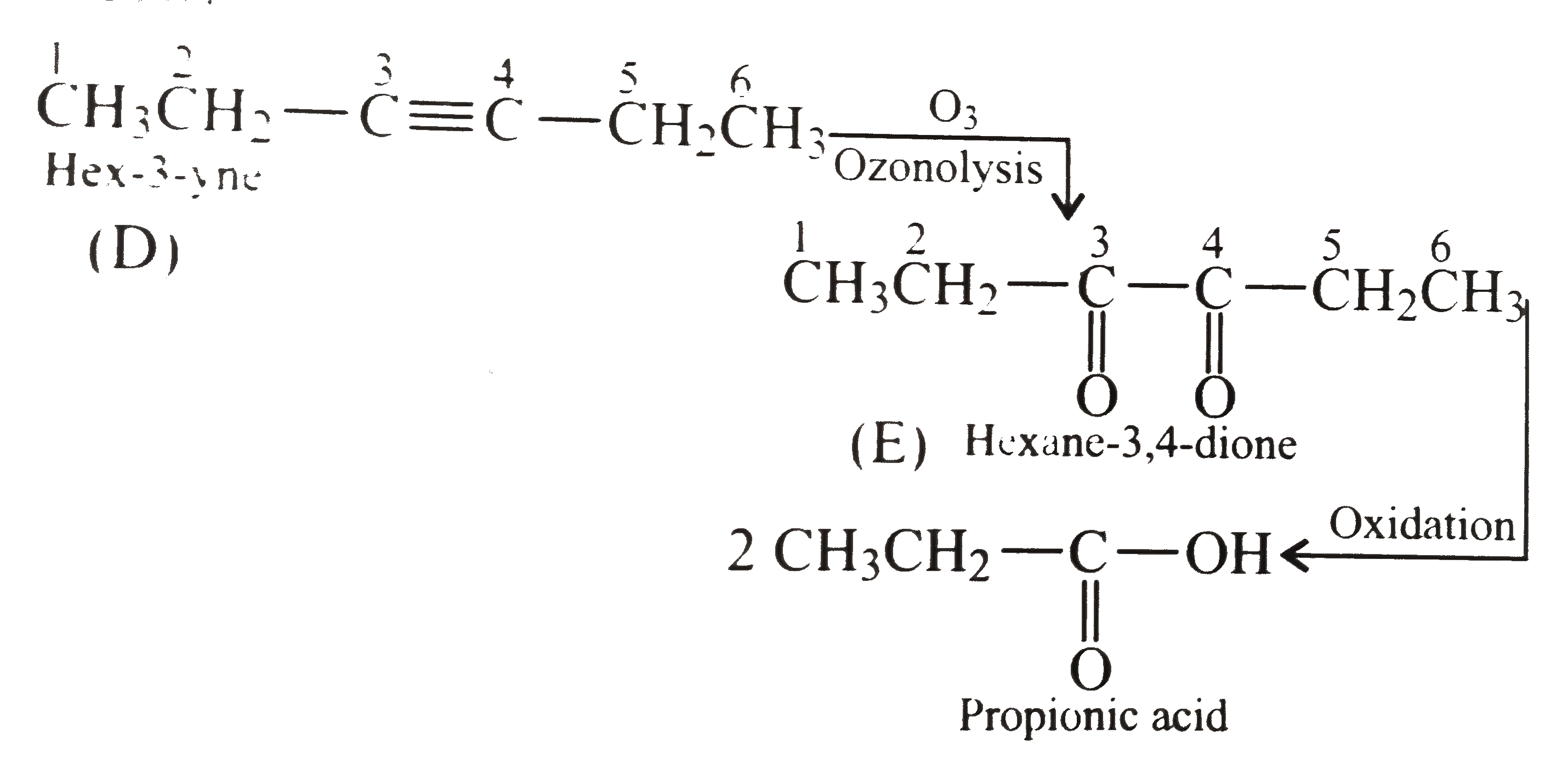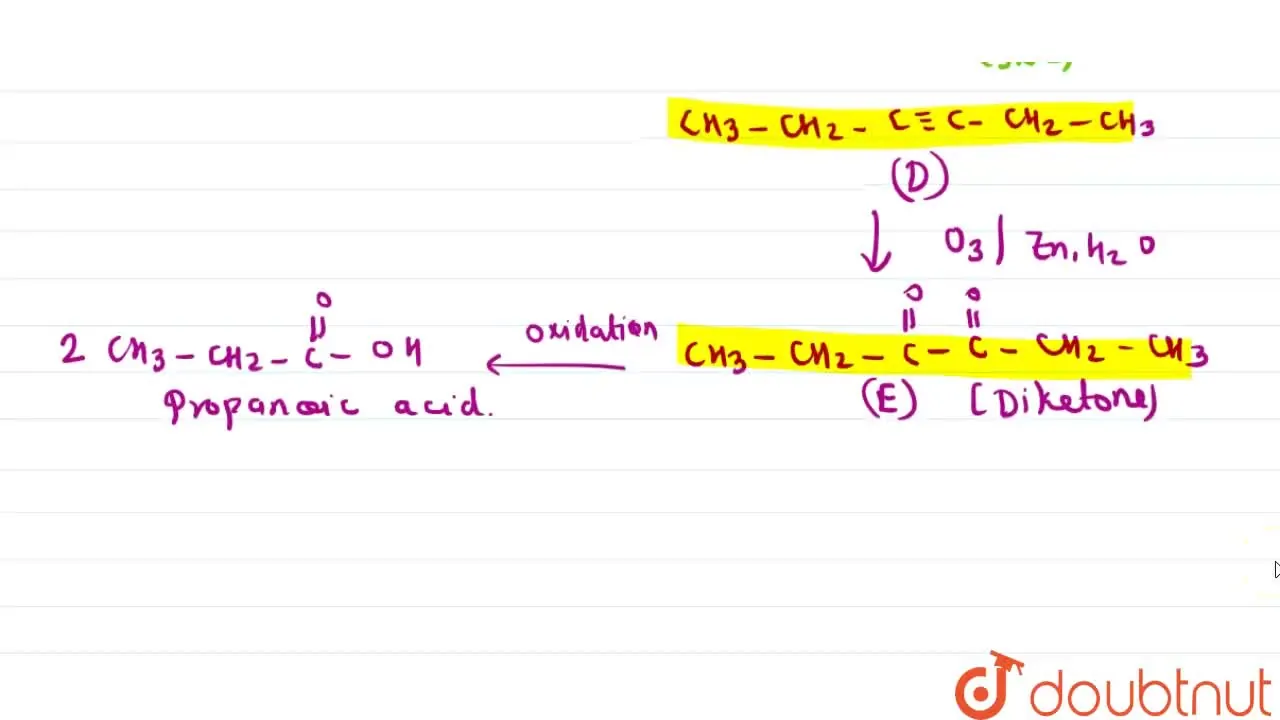A hydrocarbon (A) of molecular weight 54 reacts with an excess of Br2 in Cl4 to give a compound (B) whose molecular weight is 593% more than that of (A). However, on catalytic hydrogenation with excess of hydrogen (A) forms (C) whose molecular weight is only 7.4% more that that of (A). (A) reacts with CH3CH2Br in the presence of NaNH2 to give another hydrocarbon (D) which on ozonolyisis yields diketone (E). (E) on oxidation gives propionic acid. Give the structure of (A) to (E) with reason.
step 1. to determine the molecular weights of compounds (B) and (C)
(i). The molecular weight of compound (A) is 54 while that of compound (B), which it gives on treatment with an excess of Br2 in CCl4, is 593% more than that of (A).
Molecular weight of (B)=(100+593)100×54=374.22
Thus the increase in weight due to the adiiton of Br atoms is 374.22−54.0=320.22
Since atomic weight of Br is 80, the number of Br atoms added =320.2280=4. As such the hydrocarbon (A) must be an alkyne.
(ii). Further since the molecular weight of compound (C) which hydrocarbon (A) gives on catalytic hydrogenation, is only 7.4% more than that of (A). The molecular weight of (C) is
(100+7.4)×54100=57.994=58(approx)
Thus, the increase in weight due to the addition of H atoms =58−54=4.
Since the atomic weight of H is 1 the number of H atoms added during catalytic hydrogenation is 41=4. Therefore, hyrocarbon (A) must be an alkyne.


Related Playlists
- BOOK - CENGAGE CHEMISTRY ENGLISHCHAPTER - PURIFICATION OF ORGANIC COMPOUNDS AND QUALITATIVE AND QUANTITATIVE ANALYSISEXERCISE - SOLVED EXAMPLES17videos
PURIFICATION OF ORGANIC COMPOUNDS AND QUALITATIVE AND QUANTITATIVE ANALYSIS
- BOOK - CENGAGE CHEMISTRY ENGLISHCHAPTER - PURIFICATION OF ORGANIC COMPOUNDS AND QUALITATIVE AND QUANTITATIVE ANALYSISEXERCISE - Subjective Type11videos
PURIFICATION OF ORGANIC COMPOUNDS AND QUALITATIVE AND QUANTITATIVE ANALYSIS
- BOOK - CENGAGE CHEMISTRY ENGLISHCHAPTER - PERIODIC CLASSIFICATION OF ELEMENTS AND GENERAL INORGANIC CHEMISTRYEXERCISE - Exercises (Archives )Subjective4videos
PERIODIC CLASSIFICATION OF ELEMENTS AND GENERAL INORGANIC CHEMISTRY
- BOOK - CENGAGE CHEMISTRY ENGLISHCHAPTER - REDOX REACTIONSEXERCISE - Archives (Integers)1videos
REDOX REACTIONS
Similar Questions
Aniline reacts with excess Br2/H2O to give the major product
View Solution
Molecular weight of compound (A) is :View SolutionExcess of CH3COOH is reacted with CH≡CH in presence of Hg2+, the product is -
View SolutionAt 1 atm and 273 K the density of gas, whose molecular weight is 45, is:
View SolutionA hydrocarbon with lowest molecular weight has only one chiral carbon. Find its molecular weight.
View SolutionAn optically active compound A with molecular formula C8H14 undergoes catalytic hydrogenation to give meso compound, the structure of (A) is :
View SolutionEquivalent weight of H3PO2 is (M→ molecular weight)
View SolutionA organic compound contains 4% sulphur. Its minimum molecular weight is
View SolutionOn ozonolysis a hydrocarbon of molecular formula C4H6 gives succinin acid only. What is the structure of hydrocarbon ?
View SolutionThe empricial formula of a compound is CH2O. Its molecular weight is 120. The molecular formula of the compound is
View Solution


